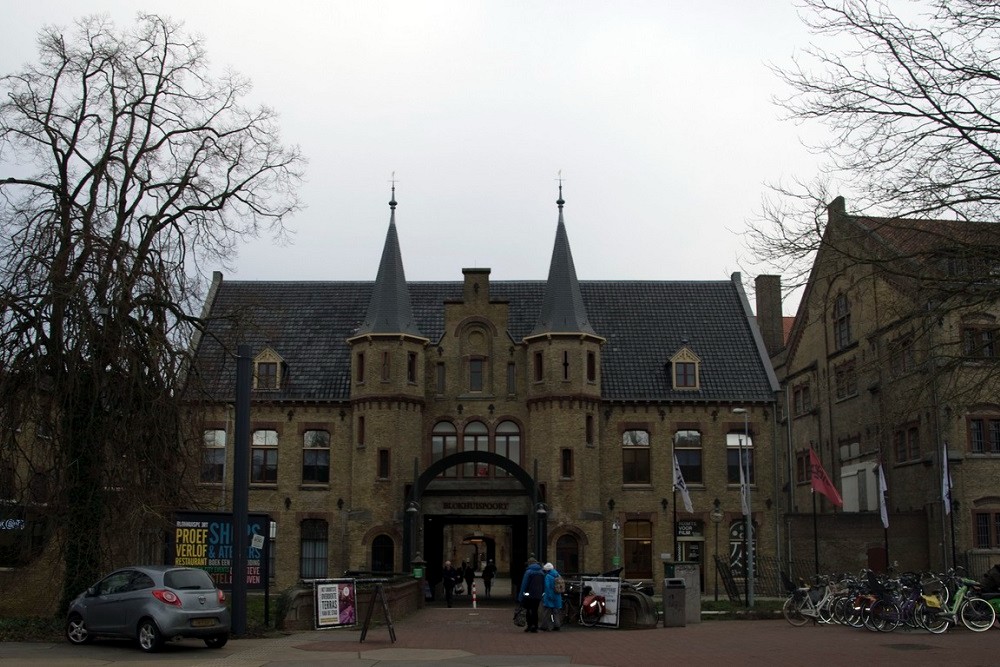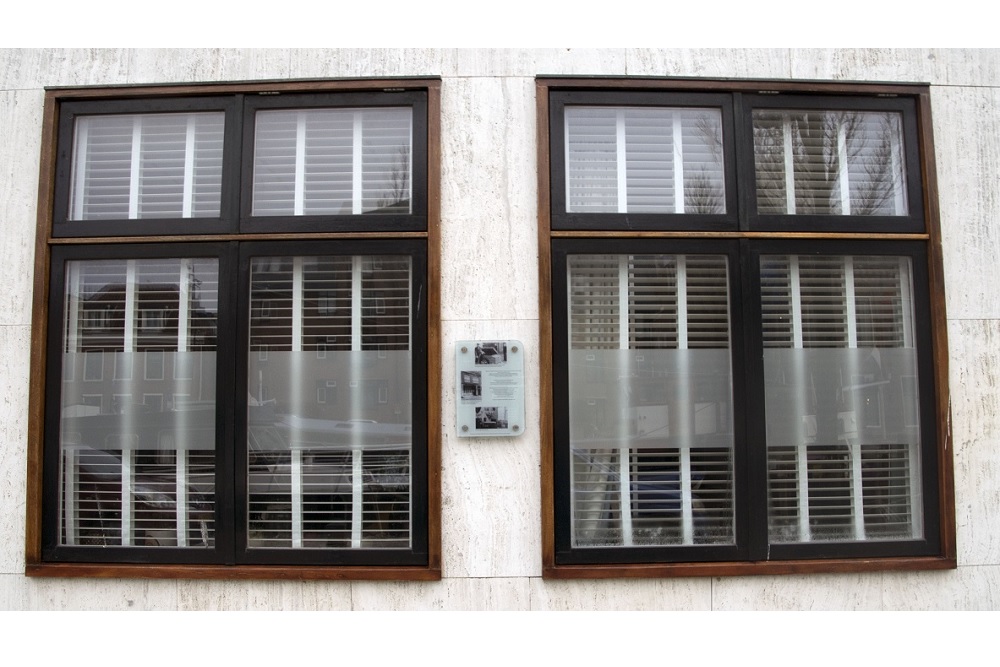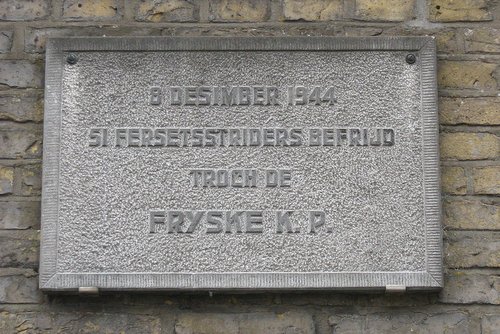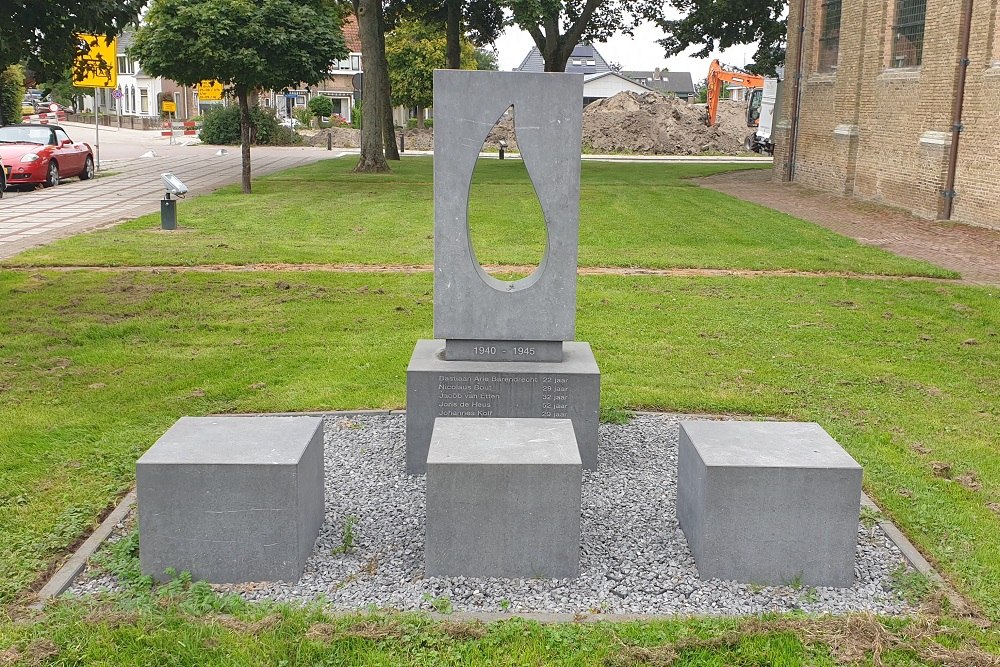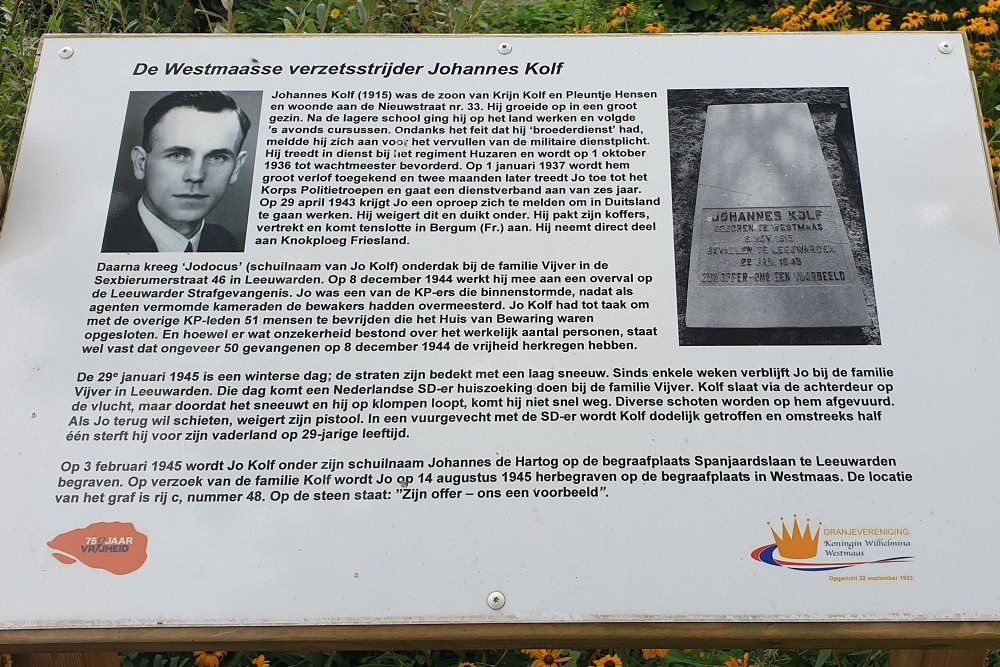Introduction
During the occupation of the Netherlands, resistance groups made several attempts to free comrades arrested by the Germans. Raids like these were very risky. The prisons were kept under close watch by the Germans; because of this it was very difficult to gain entrance. In 1944 in Amsterdam, for example, several attempts were made to raid the House of Detention on the Weteringschans. None of them were successful and that (indirectly) meant the death of a number of prominent resistance fighters, among them Gerrit Jan van der Veen and Johannes Post.
However, there were also successes. On the 11th of June, 1944 an assault group in Arnhem succeeded in freeing over 50 prisoners from the locally based House of Detention (see: Liepke Scheepstra). Another successful raid took place in Leeuwarden. Here the Frisian resistance succeeded in freeing 51 people in the night of the 8th of December, 1944. This article tells the story of this daring act of resistance.
Definitielijst
- raid
- Fast military raid in enemy territory
- resistance
- Resistance against the enemy. Often also with armed resources.
Images
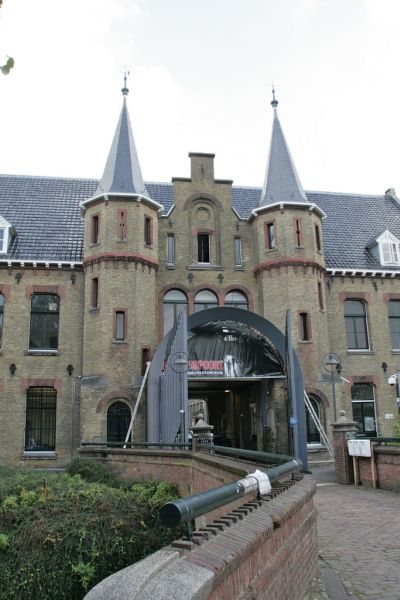 The Blokhuispoort nowadays, the spot where the raid took place. Source: Melda Wiwaba.
The Blokhuispoort nowadays, the spot where the raid took place. Source: Melda Wiwaba.Preparation
The House of Detention in Leeuwarden, more commonly known as the Blokhuispoort, dates from the sixteenth century. Since 1580 it was a jail and since 1875 it served as Convict Prison and House of Detention. The building was separated into two parts: the House of Detention (during the war political prisoners/people of the resistance were interned here) and the Convict Prison (here were mostly “normal” criminals who were sentenced to 5 years or more). All guards were of Dutch descent. The command was in the hands of deputy director Vos, who was also Dutch. The original director Jansen was interned in camp Amersfoort, because he refused to follow German orders. The deputy director had fewer qualms about this. The building was and is surrounded by a high wall with a moat around it. Furthermore, the Ortskommandantur of the Wehrmacht (the local occupying army headquarters) was established opposite. It would therefore be very difficult to free people from this building.
Still, In October 1944, the leader of the Knokploeg (KP) (Assault Group) in Friesland, Piet Kramer (pseudonym of the Dokkum timber merchant Piet Oberman), received the order to plan a raid on this prison from the regional commander of the Binnenlandse Strijdkrachten (BS) (an illegal organization called Domestic Forces). At that time a raid was not yet really necessary, because there had been no people of the resistance interned, the plan had to be made “just in case.” The raid was to be carried out by members of the Frisian KP.
For the planning, Oberman sought contact with member of the KP Egbert “Eppie” Bultsma. Bultsma knew a staff member of the prison and he approached him with the question if there were guards willing to provide intelligence about the House of Detention. Four were willing to cooperate. From them the resistance received a list of all detainees, as well as a staff schedule and several plans of the buildings. The guards that sympathised with the resistance also relayed messages from and to the prisoners.
Initially the plan was for the KP to use pass keys to provide entry to the prison. For this the cooperation of the guards was once again needed. At night they made wax prints of all keys and on the basis of these prints duplicates were made. It took more than a month to make good forgeries. Among other things because tests done by one of the helping guards showed that a number of the duplicates didn’t fit. When the resistance group finally succeeded in making fitting keys for all the locks it appeared that the plan could not go through after all. The guards reported that the order was given to barricade the only entrance to the prison with a heavy wooden beam at night. Because of this the false keys became useless.
This was a major setback for the KP. The situation was also worsened when halfway November 1944 six prominent members of the resistance were arrested, including Klaas Leijenaar and the inspector of the Leeuwarden police Jurjen Dreeuws. Dreeuws was a prominent figure in the Frisian underground movement. He had a leading position and possessed a lot of knowledge about the organisation. If he were to crack under German pressure, he would be able to provide the names of many members of the resistance. Soon, members of the Frisian assault group received message from the prison that the SD was severely torturing Dreeuws and that he would not be able to endure this much longer.
It was necessary to come into action. However, the KP saw no possibility to enter the House of Detention. Gatze Spoelstra, a police-inspector from Leeuwarden who sympathised with the underground movement, came with a new plan. He suggested that two members of the resistance be disguised as policemen who delivered three so-called prisoners. Once inside the House of Detention they would be able to overpower the present staff. Then more members of the KP would be let in, after which they could free the desired prisoners.
This plan also had a number of difficulties. It wasn’t easy to get a valid so-called inclusion warrant. These were kept at the police headquarters and they were continuously guarded. Spoelstra still managed to obtain such a document and managed to deliver it to the resistance group, so it could be meticulously copied. The original had to be put back at the headquarters as soon as possible, otherwise it would surely be noticed that it had gone missing. Because the inclusion warrants were numbered.
There was another problem that had to be solved. When the police delivered prisoners this had to be first reported in to the House of Detention. The prison staff then checked this notification by contacting the police headquarters with the question if it was correct that they were delivering prisoners.
So the Frisian underground movement needed someone who could hold these conversations and also had to divert the call from the prison, so this could be answered positively. The Frisian KP had a listening post in the Oosterstraat in Leeuwarden. Because of this they were able to monitor the telephone communications of the SD and the police and disrupt them if need be. Through this they were able to hold the first “telephone conversation” from the police station with the notification that prisoners were coming and also to answer the expected phone call verifying this in name of the headquarters. These conversations were to be conducted by police in hiding Joop Willems (pseudonym Berend). Willems resigned from the police because he refused to cooperate with collecting Jews for deportation. After this he went into hiding and became a member of the Frisian KP. When he was approached for the raid, he agreed, after some hesitation.
Another item that had to be taken care of was the choice concerning the prisoners to be liberated. The House of Detention housed 200 prisoners, who couldn’t all be freed, if only because they could not arrange enough hiding places for so many people. Eventually the Frisian KP, in consultation with other resistance groups (including the Landelijke Organisatie voor Hulp aan Onderduikers [National Organisation for Aid to People in Hiding] and the Nationaal Steun Fonds [National Aid Fund]) came to a list of 39 people who were to be freed from the Blokhuispoort. These people had the most knowledge about the underground operations; they could break during interrogations and were at risk of eventually being executed by the Germans.
Definitielijst
- Binnenlandse Strijdkrachten (BS)
- Domestic Forces. Active resistance in the Netherlands under command of Prince Bernhard. The BS was established on 5 September 1944 and consisted of the three major resistance organisations, i.e. OD, LKP and RVV.
- Jews
- Middle Eastern people with own religion that lived in Palestine. They distinguished themselves by their strong monotheism and the strict observance of the Law and tradition. During World War 2 the Jewish people were ruthlessly persecuted and annihilated by the German Nazis. . An estimated 6,000,000 Jews were exterminated.
- raid
- Fast military raid in enemy territory
- resistance
- Resistance against the enemy. Often also with armed resources.
- Wehrmacht
- German armed military forces, divided in ground forces, air force and navy.
Images
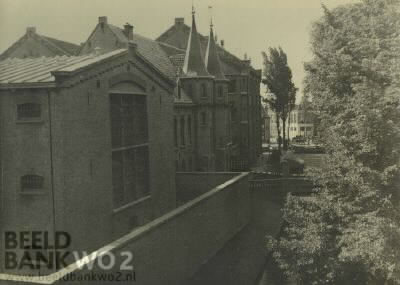 Front of the prison in Leeuwarden. Source: Beeldbank WO2.
Front of the prison in Leeuwarden. Source: Beeldbank WO2.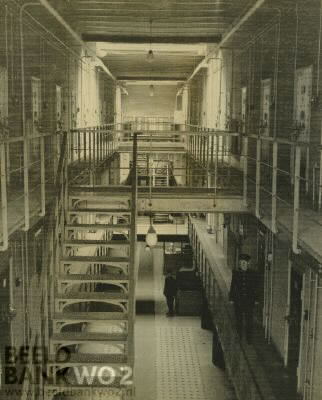 Cellblock in the prison. Source: Beeldbank WO2.
Cellblock in the prison. Source: Beeldbank WO2.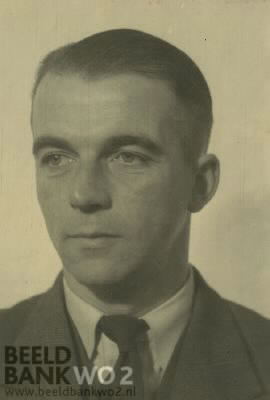 Piet Kramer, in October 1944 he got the command to plan the raid on the prison in Leeuwarden. Source: Beeldbank WO2.
Piet Kramer, in October 1944 he got the command to plan the raid on the prison in Leeuwarden. Source: Beeldbank WO2.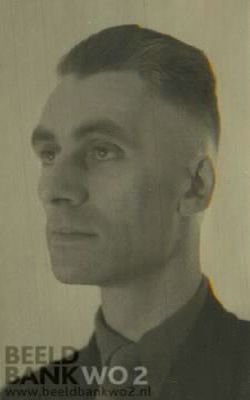 Egbert (Eppie) Bultsma, he found out which guards wanted to cooperate with the raid. Source: Beeldbank WO2.
Egbert (Eppie) Bultsma, he found out which guards wanted to cooperate with the raid. Source: Beeldbank WO2. The prison staff, that cooperated with the raid. Source: Beeldbank WO2.
The prison staff, that cooperated with the raid. Source: Beeldbank WO2.The raid
On the 8th of December 1944 the members of the resistance group gathered in the bakery of member of the KP Taco van der Veen on the Oostergrachtswal. At 15:00 the instructions took place. From this building telephone contact was made with the House of Detention reporting the delivery of three black marketeers. This phone call was made at 17:35. The report was, unlike the normal procedure, not checked by the House of Detention with the police headquarters.
Twenty-five people were to be involved with the actual raid. Six of them moved into a house on the corner of the Oosterkade and the Gedempte Keizersgracht. From here they could easily reach the entrance to the prison. The intention was that they would provide cover during the operation and that they would guarantee a safe retreat with their weapons in case of a possible discovery. For this they had access to machine guns and hand grenades. This group would only intervene in an absolute emergency, however. For it was the intention that this operation was carried out without noticeable violence.
At 17:45 the two "officers" and their three "prisoners" arrived at the House of Detention. This group consisted of the former policeman Joop Willems (pseudonym: Berend), Piet Oberman (the leader of the operation) and members of the KP Christiaan Hofing (pseudonyms: Arie and Riemer), Wim Stegenga and Jelle Visser (pseudonym: Jelle). Willems did the talking. He reported they were bringing three prisoners and showed the warrant. The doorkeeper judged it was okay and let them in. The group then overpowered, without much problem, the present guards. Following this they opened (with the keys of the doorkeeper) the front door and allowed the other 14 people of the resistance in.
After this they forced the administrator to call the Convict Prison, which was established in the same building, with the command that the prisoners Dreeuws and Leijenaar were to be brought to the House of Detention for interrogation. Dreeuws and Leijenaar were, unlike other underground workers, detained in the Convict Prison and this was the only way to get them to the House of Detention without too much commotion.
In the meantime the other members of the KP were busy freeing the prisoners. They forced the prison guards to help with this. The freed prisoners were brought to the front part of the main hall and here they received their instructions from Oberman about the course of action. The guards were locked up in one of the cells.
It took quite a while before Dreeuws and Leijenaar were at the House of Detention. They feared they would be tortured again and lingered because of this, not bothered by the Dutch guards in doing so. When they arrived together, under guard, at the House of Detention, there was great joy when it became clear they would not be interrogated, but liberated. Their guards were overpowered without much of a problem and locked up with the others.
.Everything seemed to go smoothly, until the bell at the prison gate was rung. At the door were two real members of the SD (Sicherheitsdienst = Security/Intelligence Service), who were bringing three prisoners. There was a brief panic, but Oberman quickly got the situation under control. He directed the freed prisoners to a side room and together with a couple of other members of the resistance he waited for the members of the SD. When the front door was opened and the Germans saw multiple machine guns aimed for them, they quickly surrendered. The members of the SD were disarmed and also their uniforms were taken from them. These could after all be useful for the resistance. After that they were locked up in a cell.
The three prisoners who were brought in by the SD, joined the freed prisoners. Eventually, the group of liberated men consisted of 50 prisoners and one guard. This guard (Tiemersma) had done a lot of work for the resistance group. By bringing him along all blame of the raid was intentionally placed unto him so that the other guards who helped could keep their position.
The prisoners were guided outside in small groups. They had to go to certain points in the city, where they were met by members of the BS. The prisoners had to make themselves known by giving a password. They had to ask: "Do you know what time it is?" The correct answer by members of the BS had to be: "It is high time we come home." If this procedure was followed correctly the prisoners were brought to a safe house. They would all reach these places safely.
The last members of the KP left the prison at 18:35. The raid hadn’t even lasted an hour and not a single shot was fired.
Definitielijst
- raid
- Fast military raid in enemy territory
- resistance
- Resistance against the enemy. Often also with armed resources.
Images
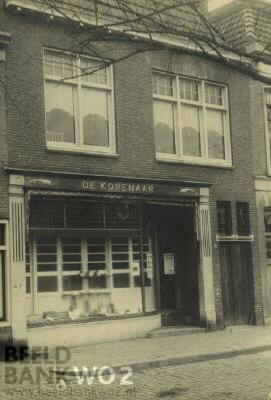 The bakery at the Oostergrachtswal, where the resistance gathered prior to the raid. Source: Beeldbank WO2.
The bakery at the Oostergrachtswal, where the resistance gathered prior to the raid. Source: Beeldbank WO2.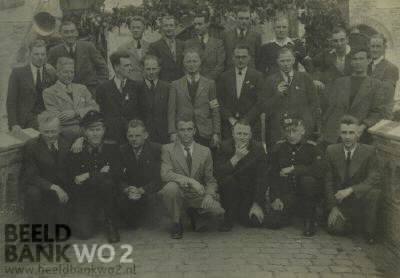 Photo of the participants in the raid. Source: Beeldbank WO2.
Photo of the participants in the raid. Source: Beeldbank WO2.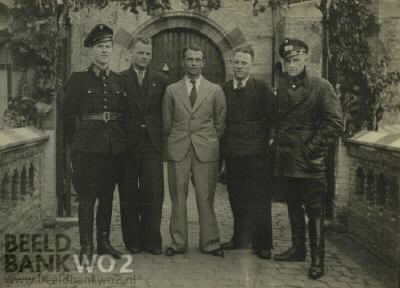 The so-called officers and their prisoners. Source: Beeldbank WO2.
The so-called officers and their prisoners. Source: Beeldbank WO2.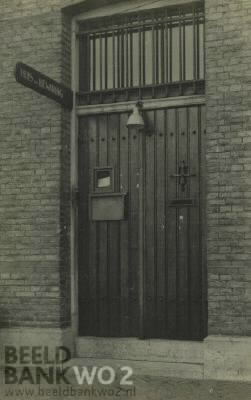 The entrance of the house of detention. Source: Beeldbank WO2.
The entrance of the house of detention. Source: Beeldbank WO2.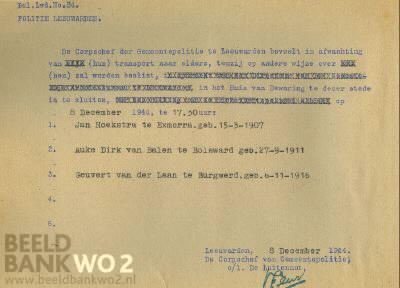 The falsified warrant. Source: Beeldbank WO2.
The falsified warrant. Source: Beeldbank WO2.Aftermath
The Germans discovered the raid at 18:45. That same evening and the next day (Saturday the 9th of December 1944) the whole city was locked down and everywhere police raids took place. The Germans were looking for the escaped prisoners and for the perpetrators of the raid. They were unable to find anyone however. Only Klaas Leijenaar was arrested by the SD later on. By then he had, however, a different identity card and wasn’t recognised as one of the prisoners freed on the 8th of December. He would survive the war. Of the 25 members of the KP involved with the raid, only Johannes Kolff (pseudonym: Jodocus) wasn’t able to be there for the liberation. He was executed by a member of the SD during a raid on his safe house on the 29th of January 1945.
There was no retaliation from the Germans following the raid, even though the SD in Groningen had strongly urged this. The reason was never fully clarified. The resistance itself argued that the Germans refrained from counter measures because the raid was non-violent. This is questioned by others, however, because the way the Germans did react in similar situations. In his standard work about the Kingdom of the Netherlands during the Second World War, Prof. Dr. Loe de Jong describes that the Ortskommandant of Leeuwarden (Reine Biehle) received a letter after the raid in which he was informed that he would be regarded as a war criminal, should he decide to retaliate. There is also criticism on this theory. It’s argued that Biehle did not have a lot of influence in Leeuwarden and that the actual command was with the SS-Hauptsturmführer Wilhelm Artur Albrecht, the commander of the SD-Aussenkommando (the SD headquarters) that was stationed in Friesland.
Albrecht supposedly refrained from strict counter measures because he was afraid of an armed revolt. It was known that the Frisian underground movement had a large weapon supply, which had been dropped by the allied forces. Furthermore, the resistance in Friesland was well organised. Therefore the Germans thought that the present resistance movement was able to unleash a full-scale revolt, comparable to the one in Warsaw a couple of months earlier. Fear of a revolt could have played a role, but then it had disappeared in January 1945. On the 22nd of January Albrecht executed 20 people in Dokkum in response to the actions of the resistance. Albrecht himself would be shot by a Dutch firing squad on the Waalsdorpervlakte as the last German war criminal on the 21st of March 1952.
In 1962 a movie was made about the raid on the House of Detention in Leeuwarden entitled De Overval (The Raid). The direction was in the hands of the Englishman Paul Rotha and the script was written by Dr. Loe de Jong. The movie became a huge success, in the Netherlands it drew over a million visitors and it was also well received abroad.
In 1985 Prince Bernard wrote the preface of the book “De kraak: de overval op de Leeuwarder Strafgevangenis, 8 december 1944” by the author Arend Jan Wijnsma:“The successful raid of the Frisian K.P. on the prison of Leeuwarden, where fifty prisoners regained freedom, was a bright spot in that dark time, which was both above and below the rivers experienced as proof of the impending liberation.
The raid on the prison in Leeuwarden filled me, as Bevelhebber Nederlandse Strijdkrachten (Commander Dutch Forces) with pride, especially because not a single shot was fired, and with gratitude because retaliation by the occupying forces failed to materialise. It seems to me that it’s very important to keep the memory of this special event during the occupation alive, especially for the generations who have not experienced the war.
Indeed, the raid in Leeuwarden shows to what extent people are willing to put their life on the line for that of their fellow men. And there’s still a need for that attitude in our society.”
On the 8th of December 2011 a commemorative plaque was revealed on the Oostergrachtswal 33. On the 8th of December 1944 the members of the resistance left from this building for the raid on the House of Detention. This plaque commemorates this event. The Blokhuispoort would also serve as House of Detention after the war (until December 2007). Since 2008 a cultural centre has been established in the building.
Definitielijst
- raid
- Fast military raid in enemy territory
- resistance
- Resistance against the enemy. Often also with armed resources.
Images
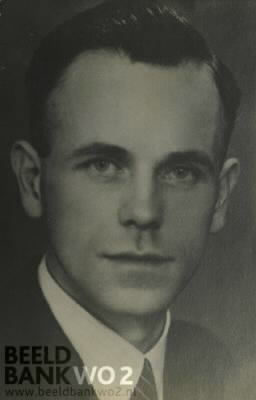 Johannes Kolf, the only participant of the raid who did not survive the war. Source: Beeldbank WO2.
Johannes Kolf, the only participant of the raid who did not survive the war. Source: Beeldbank WO2.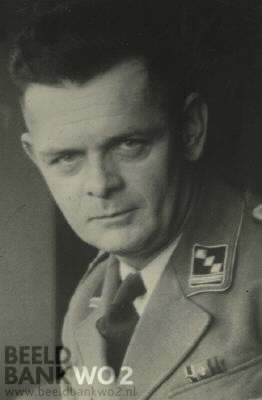 Arthur Albrecht, of the SD, he refrained from retaliation after the raid. Source: Beeldbank WO2.
Arthur Albrecht, of the SD, he refrained from retaliation after the raid. Source: Beeldbank WO2.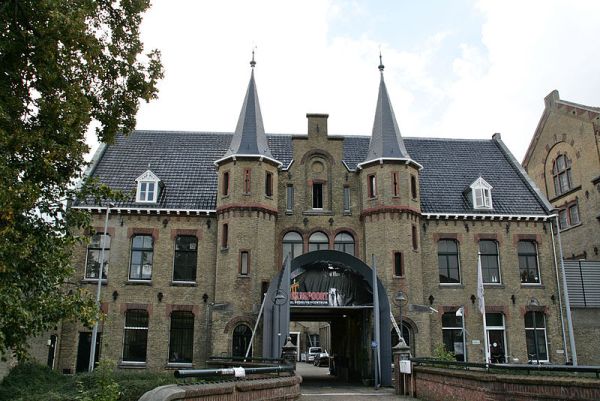 The Blokhuispoort nowadays. Source: Melda Wibawa.
The Blokhuispoort nowadays. Source: Melda Wibawa.Information
- Article by:
- Wesley Dankers
- Translated by:
- Marc Westhoeve
- Published on:
- 12-03-2013
- Last edit on:
- 18-12-2018
- Feedback?
- Send it!
Related sights
Sources
- “Bevrijding”, 8 December 1944: herinnerings-album van de "overval" op de Strafgevangenis, Prov. leiding der Friesche KP, Leeuwarden, 1946.
- HEIJDE, H. van der, “Onversneden helden bestaan niet”, Leovardia, nr.10, Leeuwarden, maart 2003, op: www.aedlevwerd.nl.
- HUISMAN, K., “Duitsers waren na overval bang voor echte opstand in Friesland”, Leeuwarder Courant, 03-12-1994.
- LEIDERMEIJER, R., “‘Misschien wel voor het laatst”’, Friesch Dagblad, 09-12-2004, op: www.aedlevwerd.nl.
- “ De overval te Leeuwarden. Commissaris Dreeuws (“inspecteur Bakker”) doet spannend verhaal over groots werk”, Nieuwsblad van het Noorden, 07-01-1963.
- www.blokhuispoort.nl
- www.halloleeuwarden.nl

